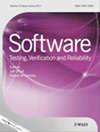线点的实证研究:一种新的过去故障算法
IF 1.2
4区 计算机科学
Q3 COMPUTER SCIENCE, SOFTWARE ENGINEERING
引用次数: 6
摘要
本文在bugspot算法的基础上,提出了一种新的故障预测算法。我们使用迄今为止最重要的自建数据集(包括用于验证的高质量样本)进行实证研究,分析了linespot与bugspot的预测性能和运行时间。作为一种新颖的故障预测方法,我们使用贝叶斯数据分析和有向无环图来模拟故障预测的效果。我们发现,对于所有七个评估指标,linespot的预测性能优于bugspot。我们得出的结论是,在所有不需要实时性能的情况下,应该使用线点而不是bug点。本文章由计算机程序翻译,如有差异,请以英文原文为准。
An empirical study of Linespots: A novel past‐fault algorithm
This paper proposes the novel past‐faults fault prediction algorithm Linespots, based on the Bugspots algorithm. We analyse the predictive performance and runtime of Linespots compared with Bugspots with an empirical study using the most significant self‐built dataset as of now, including high‐quality samples for validation. As a novelty in fault prediction, we use Bayesian data analysis and Directed Acyclic Graphs to model the effects. We found consistent improvements in the predictive performance of Linespots over Bugspots for all seven evaluation metrics. We conclude that Linespots should be used over Bugspots in all cases where no real‐time performance is necessary.
求助全文
通过发布文献求助,成功后即可免费获取论文全文。
去求助
来源期刊

Software Testing Verification & Reliability
工程技术-计算机:软件工程
CiteScore
3.70
自引率
0.00%
发文量
34
审稿时长
>12 weeks
期刊介绍:
The journal is the premier outlet for research results on the subjects of testing, verification and reliability. Readers will find useful research on issues pertaining to building better software and evaluating it.
The journal is unique in its emphasis on theoretical foundations and applications to real-world software development. The balance of theory, empirical work, and practical applications provide readers with better techniques for testing, verifying and improving the reliability of software.
The journal targets researchers, practitioners, educators and students that have a vested interest in results generated by high-quality testing, verification and reliability modeling and evaluation of software. Topics of special interest include, but are not limited to:
-New criteria for software testing and verification
-Application of existing software testing and verification techniques to new types of software, including web applications, web services, embedded software, aspect-oriented software, and software architectures
-Model based testing
-Formal verification techniques such as model-checking
-Comparison of testing and verification techniques
-Measurement of and metrics for testing, verification and reliability
-Industrial experience with cutting edge techniques
-Descriptions and evaluations of commercial and open-source software testing tools
-Reliability modeling, measurement and application
-Testing and verification of software security
-Automated test data generation
-Process issues and methods
-Non-functional testing
 求助内容:
求助内容: 应助结果提醒方式:
应助结果提醒方式:


